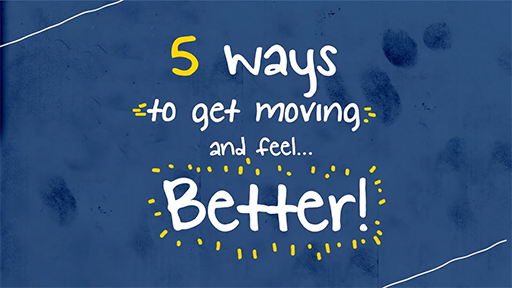4 How to become a physically active carer
As you have seen, physical inactivity is a national issue, with evidence suggesting that carers are less active than they would like to be. As you saw in Session 1, this increases their risk of poor mental and physical health outcomes. What then can be done to help carers be more physically active? The video below from mental health charity Mind offers some initial guidance, including the importance of starting with small steps.

Transcript: Video 3 5 ways to get moving and feel better
The NHS (2019a) further advocates the use of low-impact exercises and suggests yoga, walking, swimming and many more (see the Further reading section for a link to their guidance). Sport England’s Join the Movement campaign also offers guidance on how to get started with exercise. Click on each button in the Figure 4 interactive to learn more.
What can help carers take part in physical activity? Horne et al. (2021), in an examination of facilitators to physical activity in carers in the UK, identified that carers are more likely to engage in physical activity if they have an appreciation of the benefits of engaging in exercise, have previously participated in activities, utilise group activities with similar people and have some free time.
Time is a key factor for carers, with Horne et al. (2021) identifying too little time as a barrier, and sufficient time as a facilitator. However, evidence suggests that breaking the daily recommended minutes of physical activity into bitesize pieces was also of benefit to health, as you will see in Activity 5.
Activity 5
Read this article [Tip: hold Ctrl and click a link to open it in a new tab. (Hide tip)] from the BBC programme ‘Trust me I’m a Doctor’ and watch the embedded video. Reflect on the small study findings and consider how this might support you, or our case study carers to complete 30 minutes of physical activity a day. Open the article in a new tab or window by holding down Ctrl (or Cmd on a Mac) when you click on the link. Return here when you have finished.
Discussion
The study found that 5-minute ‘snacking’ of physical activity was as beneficial as completing a 30-minute session for the small sample used. You might have reflected that having this choice of approach to physical activity (either a block or a snack) is helpful to you and the case study carers. You might also have considered that the 5-minute snacking might be more manageable for carers who are restricted in their free time or have the opportunity to do this at work.
One of the study participants in the research suggested that the 5-minute snacking approach to physical activity would suit her during the working day. To facilitate this you might, for example, reduce sitting time at the desk, take a short walk at lunchtime, park further away in the car park or get off at an earlier bus stop. Guidance on how to exercise during the workday can be found in the Further reading section at the end of this session.
